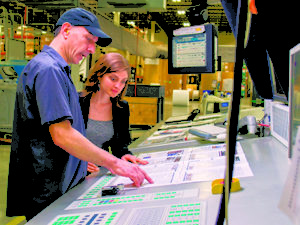Career Opportunities
Photographer/Videographer
 The photographer produces the images required for a variety of reproduction including websites, catalogs, brochures, billboards, books and advertising materials. Both static and moving video imaging are part of this position. Photographers must have proven creative talent, as well as the ability to get along with others during a photo shoot. Due to the use of digital cameras, photographers must be familiar with digital and computer technologies.
The photographer produces the images required for a variety of reproduction including websites, catalogs, brochures, billboards, books and advertising materials. Both static and moving video imaging are part of this position. Photographers must have proven creative talent, as well as the ability to get along with others during a photo shoot. Due to the use of digital cameras, photographers must be familiar with digital and computer technologies.
Print Buyer
The print buyer contacts various vendors, such as designers, writers, photographers, and printers, and ask them to bid on a specific project. They coordinate production to achieve a mix of effective costs, timely delivery, best quality, and/or most creative ideas—whichever is more important to the buyer. A print buyer must be very organized and able to work with many different people under time sensitive conditions.
Copywriter
 The copywriter starts the process of production by writing the text for the piece to be created. They can be technical, creative, marketing or journalistic writers. A copywriter should have a good command of the language and the ability to be concise and accurate. Copy writers work in business firms, software development companies, advertising and public relations, and other industries
The copywriter starts the process of production by writing the text for the piece to be created. They can be technical, creative, marketing or journalistic writers. A copywriter should have a good command of the language and the ability to be concise and accurate. Copy writers work in business firms, software development companies, advertising and public relations, and other industries
Sales Advisor
The sales representative solicits business for an organization on its behalf. They work with clients to determine their needs, and then create solutions to ensure a smooth sales process.
They may represent any type of graphic solutions provider, or may represent a company that is a vendor to the graphics industry. Excellent communication skills (including listening skills), knowledge of products that are being sold, willingness to continue to learn new things and the ability to bounce back after being rejected are all important characteristics of a professional sales representative.
Customer Service Representative
The customer service representative, or CSR, functions as a liaison between production and the customer once a job has entered the manufacturing facility. If there are any questions or problems concerning a job, the CSR must be able to communicate fluently with the buyer and must understand the customer’s needs. A CSR should be knowledgeable about the production process, and have good communication skills, to interact effectively with customers as well as internal personnel.
Graphic Designer
 The designer plans the piece to be printed and establishes the theme and style of the printed piece. Materials are created utilizing computerized design tools and programs. Designers should have
The designer plans the piece to be printed and establishes the theme and style of the printed piece. Materials are created utilizing computerized design tools and programs. Designers should have
Illustrator
The illustrator creates illustrations, drawings, charts, graphs, or full-color artwork to complement the written word. Most illustrations are now created using computerized software programs. However, an illustrator must still have precise artistic talent as well as a knowledge of composition and proper use of the tools of the craft.
Page-layout Artist
The page-layout artist uses a computer workstation to assemble the artwork and the text according to the designer’s layout. Since the artist prepares the piece for production, the job requires precision, accuracy, neatness, and the ability to follow directions. With modern software systems in use, one person often performs all the functions of the graphic designer, illustrator, and page-layout artist. Therefore, the person needs a well-rounded knowledge of computer software, in addition to having artistic ability.
Social Media/Web Specialist
 Many projects are distributed by a variety of channels and print/mail is often coordinated with web based methods. The specialist may coordinate e-blasts, manage database files, update websites and other tasks related to electronic communications with clients.
Many projects are distributed by a variety of channels and print/mail is often coordinated with web based methods. The specialist may coordinate e-blasts, manage database files, update websites and other tasks related to electronic communications with clients.
Mail Data Specialist
The specialist administers and oversees direct mail projects, data cleansing and manipulation, statistical reporting and analysis, and utilizes mailing list management software. They are a key to the relationship between clients and effective use of mail resources. Qualities of the position include organization skills with an ability to prioritize and manage multiple tasks and a variety of demands, strong self-motivation, commitment to maintain confidentiality, high degree of accuracy, and ability to work accurately and effectively with computerized data systems.
Electronic Pre-press Tech
The Prepress Technician uses software to perform a variety of functions that are key to the production and processing of a job. Depending on the production method being utilized, these may include a number of related functions such as pre-flighting, scanning of images, file repair, trapping, imposition, outputting of proofs or plates, and finalizing files for reproduction.
Educator
An educator specializing in graphic communications stimulates the students’ interest in the topic by presenting an accurate and up-to-date picture of the state of the industry. Opportunities for teaching graphic communications courses are available in high schools, vocational/technical schools, colleges and universities. Opportunities also exist within the industry itself, as many suppliers to the industry maintain training programs that are made available to their clients.
Production Manager or Coordinator
 The production manager or coordinator organizes traffic flow for production, or manufacturing jobs through the plant, making sure that each piece of material gets where it should go at the proper time and in the proper sequence, from the time the job enters the plant until delivered. Production managers should be well-organized individuals, able to plan ahead, foresee and troubleshoot problems, and be level-headed in their interactions.
The production manager or coordinator organizes traffic flow for production, or manufacturing jobs through the plant, making sure that each piece of material gets where it should go at the proper time and in the proper sequence, from the time the job enters the plant until delivered. Production managers should be well-organized individuals, able to plan ahead, foresee and troubleshoot problems, and be level-headed in their interactions.
Project Estimator
The estimator determines the most efficient method in which a particular project can be produced in their plant once they receive all specifications from the client or print buyer. The estimator’s analysis, production recommendations and predicted project resources are the basis for the firm’s bid on a job. Key qualifications for this role include an analytical mind, comfort with computer programs and a good grasp of numbers.
Department Supervisor
A department supervisor or manager is responsible for the personnel who function in that area of the company. They may make recommendations for equipment and personnel to senior management and will be responsible for the performance of their area. Normally achieving this position will come after serving for some years in a production role. Leadership and communication skills are required.
Marketing, Internet or Social Media Specialist
 These specialists work in the public relations, advertising, or marketing areas either for graphic service providers or vendors to them. Specialists in marketing often analyze where and how the company can do its business more efficiently. Advertising and social media personnel are responsible for promoting the work of the company through campaigns utilizing a broad range of channels from social media through printed means. Individuals should be creative and comfortable in the tech world.
These specialists work in the public relations, advertising, or marketing areas either for graphic service providers or vendors to them. Specialists in marketing often analyze where and how the company can do its business more efficiently. Advertising and social media personnel are responsible for promoting the work of the company through campaigns utilizing a broad range of channels from social media through printed means. Individuals should be creative and comfortable in the tech world.
Engineer or Scientist
The engineer designs machinery, and the scientist conducts research in all aspects of the industry such as ink formulation, papermaking, health and safety standards, and quality control. Broad use of computerized programs leads to a demand for electrical engineers, mechanical engineers, and computer specialists along with chemists, physicists, mathematicians, optical engineers, and color specialists. Many of these positions are found with companies that serve as vendors to the graphics industry.
Lean Manufacturing Coordinator
Job consists of developing and implementing an action plan for lean process improvement, and work with management to identify, develop and implement continuous improvement projects, cost reductions, product quality enhancements, and process effectiveness improvement. Knowledge of six sigma methodologies, analytical and cognitive skills, project management ability and software knowledge are required.
Press Operator
The press operator runs multi-million-dollar printing presses, putting “ink on paper”. Commercial press operators must know the mechanical workings of the machine, possess good manual dexterity, and think quickly on their feet to produce a top-quality product efficiently. Modern machines, whether sheet or web fed, have many automated or computerized features requiring technical skills as well.
Digital Operator
Digital devices utilizing ink jet or toner based technologies are common in nearly all production facilities today. They require a more technically skilled orientation, along with color knowledge and the ability to quickly adapt from one job sequence to another. Hardware and software advances are nearly continuous in this area.
Bindery Operators
The bindery typically performs one or more finishing functions to bring a project to completion. These include cutting, folding, gathering, collating, trimming, die-cutting and binding the final printed piece. Most bindery operators must be able to operate various kinds of machinery, so ground-level training on each piece of equipment is important. Good mechanical ability and functional flexibility are requirements. Modern machines have automated features, so comfort with those capabilities are needed as well.
Material Coordinator
Materials personnel are responsible for the logistics of receiving, staging and distributing materials throughout the production facility. This includes both raw and finished products and may also consist of fulfillment of products to other businesses. Much of this work is done using mechanical equipment, but some manual labor is required. Mechanical skills and physical abilities are needed.
Wide Format Specialist
The production of wide format, or display imaging, materials is offered by many providers throughout the industry. Wide format printing is accomplished using a variety of substrates and finishes to produce displays, banners, fixtures, and much more. Wide format specialists must be flexible and creative to handle a large variety of projects.
Obviously, not every career in graphic communications can be listed here. These are simply some of the ones asked about most often. The educational requirements for these careers vary according to the type of work, size of company, and amount of responsibility.

